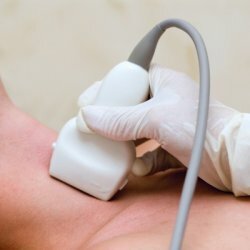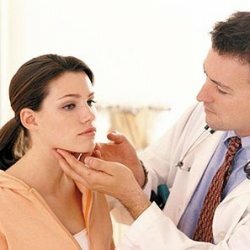Thyroid function research

Determination of the level of thyroid hormones and pituitary gland
- Total thyroxine( T4).In this case, the total content in the blood of both protein-bound and free thyroxin is determined.
Therefore, if your doctor prescribes a thyroxine level study, and anything of the foregoing has anything to do with you, tell your doctor.
- Free thyroxine( CT4).In this study, only the part of thyroxine that is in the blood in the free state is determined, which is approximately 0.03% of the total thyroxine level.
- level of CT4 can be lowered in patients with severe chronic disease;
- , the content of CT4 is increased in acute diseases and in patients receiving anticoagulants.
- Free triiodothyronine( CT3).The study is rarely performed, usually only when the patient has a clinical picture of thyrotoxicosis, and the level of free thyroxin is within normal limits.
- Thyroid-stimulating hormone of the pituitary gland( TTG).Definition of it is considered the most sensitive in the study of thyroid function. The level decreases with an increase in the thyroxine content and increases with a decrease in T4.Therefore, if you have hyperthyroidism, then the TSH content is reduced, and if hypothyroidism is increased.
Some factors may have a significant effect on the level of thyroid-stimulating hormone. So, it goes down:
- with excessive replacement therapy with thyroid hormones;
- with thyroid nodules actively producing hormones;
- in the first trimester of pregnancy due to the action of the hormone of the chorionic gonadotropin.
Among the factors that cause an increase in the thyroid-stimulating hormone level, it should be noted:
- iodine deficiency;
- period of recovery from a serious illness;
- adrenal insufficiency;
- is a mental illness.
You should remember that the values of the hormones that you define may differ slightly if the studies were performed in different laboratories, because of the possible differences in the methods used. Therefore, first, we should not compare the analyzes performed in them, and secondly, it is better to choose one laboratory and use only its services.
Definition of antibodies to thyroid tissue components
A study is usually assigned to confirm a diagnosis if the doctor has suspected an autoimmune thyroid disease.
High values of antibodies are found in autoimmune thyroiditis, and sometimes in diffuse toxic goiter. Antibodies in low titre are detected in 10% of healthy people.
Radioactive iodine thyroid seizure and
scan Because thyroid cells take iodine from the blood to produce hormones, the patient is given a swallow capsule with radioactive iodine to receive the scan, and then a special sensor similar to the Geiger counter is moved over the thyroid gland. Scintillation in its various departments is fixed by the device and marked as separate points on paper.
If the shape of the gland and the absorption of radioactive iodine are normal, then a butterfly pattern is obtained with a uniform absorption of the radiopharmaceutical throughout the gland's area.
In the presence of a node that heavily absorbs radioactive iodine, a spot can be seen on the scan in this place, since most of the drug is concentrated in the node.
This node is called "hot" and has increased functional activity. In other parts of the gland, absorption can be reduced. And, on the contrary, if the node does not absorb iodine at all, then there will be a site on the scan in which the concentration of the drug is absent. Such a node is called "cold", its functional activity is reduced and such nodes are more often malignant.
However, remember that having a cold node on your scan is only an indirect sign that allows you to talk only about the greater probability of its malignancy.
In addition to determining the shape, size and functional activity of individual sections of the gland, the study of the absorption of radioactive iodine makes it possible to evaluate its activity.
If the activity is excessive, the iron absorbs more iodine than normal, and if insufficient, then less. The maximum capture is normal after 24 hours and is about 25% of the normal dose.
In some situations, normal capture and scanning are not possible. This happens:
- when taking medications containing iodine;
- with thyroid hormone replacement therapy;
- for certain thyroid disorders.
Stay healthy!



